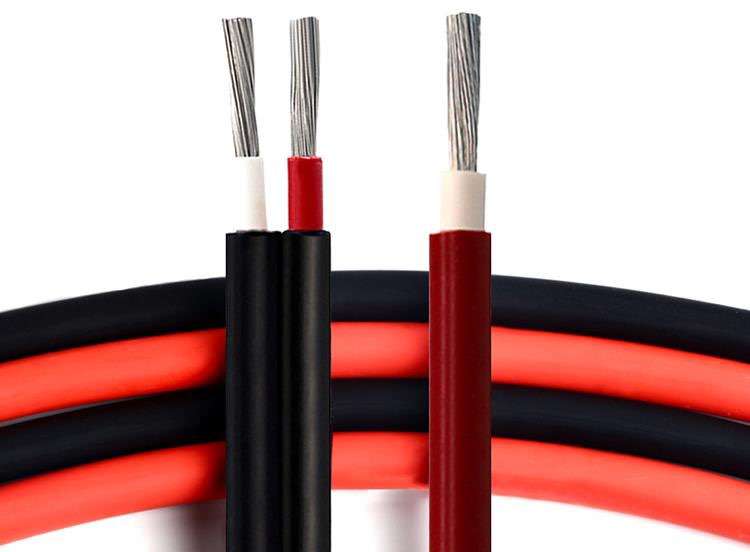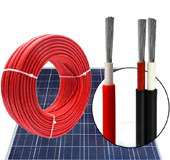 Author: Joey Wan
Author: Joey Wan  November 17,2021
November 17,2021
Solar wire are solar photovoltaic wires
Solar wire is a wire produced by using advanced high-energy ray irradiation cross-linking technology and using low-smoke, halogen-free, flame-retardant and environmentally friendly materials. It has high temperature resistance, ozone resistance, UV resistance, water vapor resistance, antimicrobial resistance, and short-term overload capabilities. It has the advantages of strong, long life, wear resistance, oil resistance, corrosion resistance, high tensile resistance, etc., and can be widely used in various fields such as solar power stations and photovoltaic systems.

The difference between solar wire and ordinary cables
Common solar wire models: PV1-F, H1Z2Z2-K, 62930IEC131, etc.
Common common cable models: RV, BV, BVR, YJV, VV and other single-core cables
The difference in usage requirements:
1. The rated voltage is different
Solar wire: 600/1000V or new standard 1000/1500V;
Ordinary cable: 300/500V or 450/750V or 600/1000V (YJV/VV series)
Different adaptability to the environment
Solar wire: need high temperature resistance, cold resistance, oil resistance, acid and alkali salt resistance, rain resistance, UV resistance, flame retardancy, environmental protection, and can be used in harsh environments with a service life of more than 25 years.
Ordinary cables: generally used for indoor laying, buried pipes and electrical equipment connections, etc., have a certain temperature and oil resistance, but cannot be exposed outdoors and in harsh environments. The service life is generally based on actual conditions without special requirements .
The difference between raw materials and processing technology
1. Different raw materials
Solar wire:
Conductor: tinned copper wire conductor
Insulation: cross-linked polyolefin insulation
Sheath: cross-linked polyolefin insulation
Ordinary cable:
Conductor: copper conductor
Insulation: PVC or polyethylene insulation
Sheath: PVC sheath
2. Different processing technology
Solar wire: the outer skins are all cross-linked and irradiated
Ordinary cables: generally do not undergo cross-linking radiation, YJV\YJY series power cables will be cross-linked
Here is a supplementary introduction to the cross-linking irradiation process, so that everyone can have more understanding.
Irradiation crosslinking of solar wire uses high-energy electron beams generated by an electron accelerator to bombard the insulating layer, breaking the molecular chain to form polymer free radicals, and then polymer free radicals recombine the cross-linking bonds, so that the original linear molecular structure becomes a three-dimensional network Shaped molecular structure to form crosslinks. The radiation cross-linked wire can withstand a temperature of 300 degrees instantaneously, and can work normally at 125 degrees. It has excellent mechanical and physical properties, good resistance to environmental stress cracking, excellent wear resistance, and can withstand concentrated mechanical stress better than PVC and PE. The outer diameter of the radiation cross-linked polyolefin insulated wire is smaller than that of the full polyvinyl chloride insulated wire of the same cross-section. The pipe diameter can be reduced during the pipe-through construction, or more wires can be pierced under the same pipe diameter. , Reduce construction and installation costs. Irradiation cross-linked polyolefin insulated wire products are much lighter than polyvinyl chloride insulated wire products, and are easier to install and transport, reduce labor intensity, and reduce transportation costs.
The certification is different
Solar wire generally require TUV certification. Ordinary cables generally require only production licenses. In China, CCC certification is generally required.

Why do household photovoltaic systems use copper solar wires?
In household photovoltaic systems, in order to reduce power loss, protect people's lives and property, and extend the life of the system, copper solar wire are recommended. Aluminum wire is easier to catch fire than copper wire. In electrical circuits, the fire hazard of aluminum wire is much greater than that of copper wire. In fact, the fire of the aluminum wire is not caused by the aluminum wire itself but by the connection of the aluminum wire. Compared with copper wire, the most direct cause of fire hazard in connection with aluminum wire is electrical resistance
Because there is more or less film resistance on the surface of the conductor. If the film resistance causes the connection to overheat, the overheating will increase the film resistance, and the conductivity will deteriorate. This type of overheating is particularly serious in the aluminum wire connection. This is because even if the surface of the aluminum wire is scratched and clean, it only needs to be exposed to the air for a few seconds to be oxidized and immediately form an aluminum oxide film. Although its thickness is only a few micrometers, it has a very high resistivity, thus presenting a large film resistance. Therefore, when the aluminum wire is connected, the conductive paste should be applied immediately after scratching the surface of the aluminum wire to cut off the contact between the surface of the aluminum wire and the air, otherwise it will increase the contact resistance.
The above are the main differences between solar wire and ordinary cables that I learned and summarized during my work in JZD Wire&Cable company in China and in the end I hope it can help you and also you can visit our site to see more about our products, such as the THHN cable, H05VV-F and so on.
Extension Information
How Many Watts Is 1.5mm Wire Load Capacity?
Everything You Should Know About Ethernet Cat 5e
